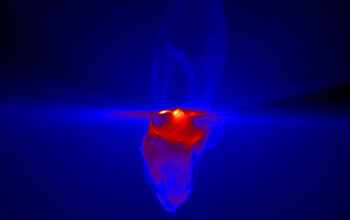Multimedia Gallery
Simulated Observation of a Massive Star
A simulated observation of a massive star viewed along the plane of the disk. This visualization of dust emission traces the density and temperature of the gas cloud that surrounds the star. The regions that are currently ionized (in red) and have been ionized in the past (blue structures) show how the surrounding nebula flickers.
Simulations by researchers show that as the gas cloud collapses, it forms dense filamentary structures that absorb the star's radiation when it passes through them. Stars form when huge clouds of gas collapse. Once the central density and temperature are high enough, hydrogen begins to fuse into helium and the star begins to shine. The most massive stars, though, begin to shine while the clouds are still collapsing. Their ultraviolet light ionizes the surrounding gas, forming a nebula with a temperature of 10,000 degrees Celsius. This suggests that the growth of a massive star should taper off or even cease because the surrounding gas should be blown away by the heating.
The simulations were run on supercomputers at the Texas Advanced Computing Center, funded by the National Science Foundation (NSF), and at the Leibniz and Jxlich Computing Centers in Germany. The research was funded in part by the NSF Astronomy Division (grant AST 08-35734). To learn more about this research, see the American Museum of Natural History news story Simulations Solve a 20 year-old-Riddle About Why Nebulae Around Massive Stars Don't Disappear. (Date of Image: 2010)
Credit: T. Peters et al. (2010)
See other images like this on your iPhone or iPad download NSF Science Zone on the Apple App Store.
Images and other media in the National Science Foundation Multimedia Gallery are available for use in print and electronic material by NSF employees, members of the media, university staff, teachers and the general public. All media in the gallery are intended for personal, educational and nonprofit/non-commercial use only.
Images credited to the National Science Foundation, a federal agency, are in the public domain. The images were created by employees of the United States Government as part of their official duties or prepared by contractors as "works for hire" for NSF. You may freely use NSF-credited images and, at your discretion, credit NSF with a "Courtesy: National Science Foundation" notation.
Additional information about general usage can be found in Conditions.
Also Available:
Download the high-resolution JPG version of the image. (448 KB)
Use your mouse to right-click (Mac users may need to Ctrl-click) the link above and choose the option that will save the file or target to your computer.



